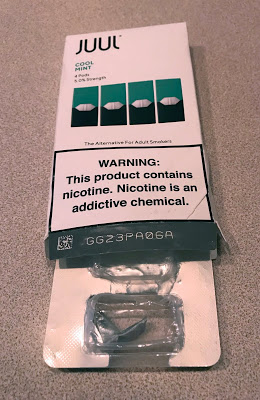Op-ed calls for smoking bans to include e-cigs and for an e-cig tax to decrease teen use; new e-cigs are easy for teens to hide

A used package of Juul cartridges, found
on a Frankfort sidewalk. (Photo by Al Cross)
As students head back to school and concerns about their increasing use of a new electronic cigarette product called Juul emerge, anti-smoking advocates call for school districts and locales to enact 100 percent smoke-free laws that include electronic cigarettes and for state officials to tax e-cigarette devices and their liquids at the same rate as conventional tobacco products.
“It is alarming that children are not allowed to chew gum in class, but they are using e-cigarettes in school,” Ellen J. Hahn and Melinda J. Ickes write in an op-ed for the Lexington Herald-Leader.
Hahn is a professor in the University of Kentucky College of Nursing and the director of BREATHE (for Bridging Research Efforts and Advocacy Toward Healthy Environments) and the Kentucky Center for Smoke-free Policy. Ickes is an associate professor in UK’s Department of Kinesiology and Health Promotion and director of Go Tobacco-free, an initiative to promote tobacco-free college campuses.
The worries Hahn and Ickes are widely shared. In April, the U.S. Food and Drug Administration was so concerned about the inappropriate sale of e-cigarettes to kids that it conducted an undercover “blitz” that particularly targeted the hugely popular Juul products. The Washington Post reported that the blitz found dozens of violations of the laws and issued 40 warning letters related to Juul sales.
Taxing e-cigarettes was an idea considered but dropped this year by the Kentucky General Assembly. The legislature raised the state cigarette tax by 50 cents a pack, to $1.10, but in the final hours of the legislative session, a plan to add a 15 percent tax on electronic cigarettes was dropped.
Hahn and Ickes write that the Juul product appeals to youth because it “rids the noxious taste and sensation of the initial smoking experience” and because the devices are easy to hide from parents and teachers because they look like computer USB drives.
The authors add that “the proportion of U.S. high-school students using e-cigarettes went up 800 percent from 2011 to 2014,” and that while there was a slight reduction in smoking, or vaping, e-cigarettes in 2016 among youth, “today more youth in Kentucky and the U.S. smoke e-cigarettes than smoke traditional cigarettes.”
They also point out that the aerosol in e-cigarettes is not a harmless water vapor as advertisements suggest, but instead “contains nicotine, tiny particles, sweet appealing flavorings and toxic chemicals.” They write, “One pod is equivalent to the nicotine content in 20 conventional cigarettes. Nicotine harms brain development in children and young adults, and it is highly addictive.”
Experts also worry that the use of these products will lead to use of conventional cigarettes and that they are being used to inhale other drugs.
Some schools have banned the use of USB drives as a way to curb the problem, but the authors write that there is little schools can do to thwart the aggressive e-cigarette advertisements found on social media and at venues, like music festivals, that are frequented by teens. It is also hard to battle the appealing flavors in the products that users say are the main reason they started using them.
Also, “Tobacco companies offer scholarships of $250 to $5,000 to students who write essays on the potential benefits of e-cigarettes,” the authors write.
That said, there has been some progress. All 17 companies that were warned in May to stop marketing their electronic cigarette liquids in packaging that resembled “kid-friendly food products”, like juice boxes, have stopped doing so, though the FDA warned the companies that it is still watching.